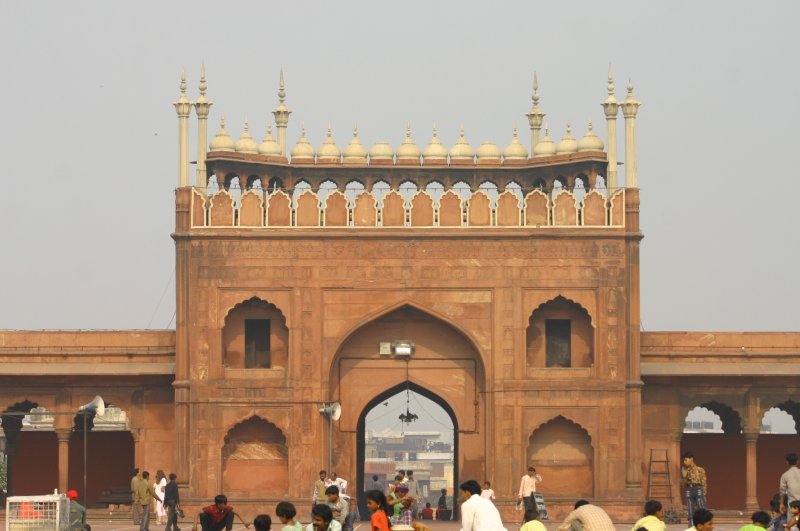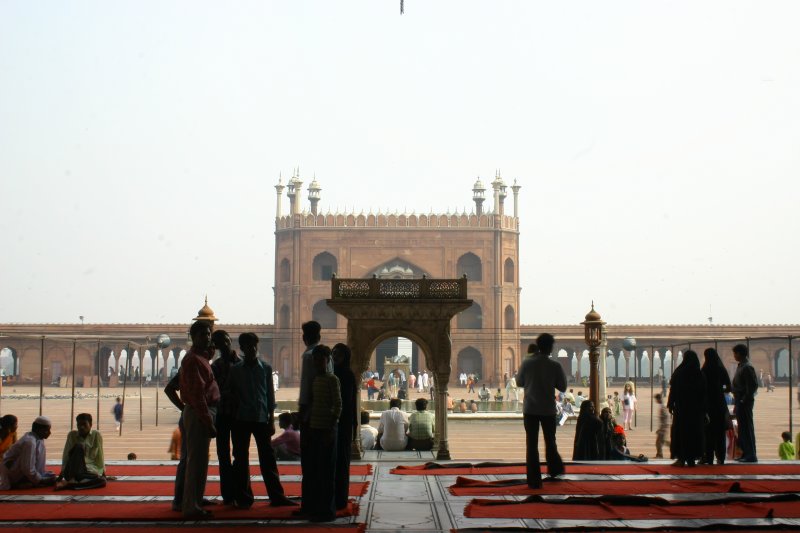 Jama Masjid, Old Delhi (19 November, 2004)
Jama Masjid, Old Delhi (19 November, 2004)
Jama Masjid (GPS: 28.65024, 77.23367) is the main mosque for New Delhi. Situated in the ancient town of Old Delhi, it is also the largest mosque in India. I explored it on foot at the end of a tour of India which I organised. The Jama Masjid represents a fine example of Mughal era architecture in mosque design.
Built by Emperor Shah Jahan (the builder of the Taj Mahal) between 1644 and 1658, the mosque was originally called the Masjid-i-Jahanuma (also written Masjid-i-Jahan Numa) meaning "Mosque commanding a view of the world". This part of Delhi still retains the old-world charm of markets in Mughal times.
To the east, the Jama Masjid faces the Lal Qila (Red Fort) and has three gateways, four towers and two minarets. Constructed of alternating vertical strips of red sandstone and white marble, and measuring 65m by 35m, the Jama Masjid is the largest and one of the most magnificent mosques in India.
 View of the grand stairway leading up towards the arched main entrance of Jama Masjid. (19 November, 2004)
View of the grand stairway leading up towards the arched main entrance of Jama Masjid. (19 November, 2004)
Broad flights of steps lead up to the imposing gateways in the north and the south. The main eastern entrance, probably used by the emperors, remains closed on most days of the week. Near the north gate of the Jama Masjid stands a cupboard containing a collection of Muhammad's relics - Korans written on deerskin, a red beard-hair of the prophet, his sandals and his footprint, embedded in a marble slab.
The structure was placed on a high platform so that its magnificent facade would be visible from all around. It's an austere yet beautiful building. The pulpit is one of its best features, being carved out of a single block of marble.
Constructed by Shah Jahan in the 17th century A.D, Jama Masjid, near the Red Fort is the biggest mosque in India. The Jama Masjid is constructed on a high platform with three onion shaped domes adorned with black stripes. It has four minarets in four corners. Its courtyard has a reservoir of water in the center. This courtyard can gather as many as 10,000 people at a time. This mosque is constructed in red sandstone with inlaid white marble. Its construction began in 1644 A.D. and was completed in 1658 A.D. In the absence of royal patronage, art and architecture did not flourish, after the reign of Shah Jahan.
 Grand entrance gate to Jama Masjid. (19 November, 2004)
Grand entrance gate to Jama Masjid. (19 November, 2004)
A perfect example of Mughal architecture, the Jama Masjid has three gateways. The largest and highest on the east was reserve exclusively for the emperor. The main courtyard of the mosque is 408 square feet and paved with red stone. In the centre is a large marble tank in which the devout wash before attending prayers.
The Jama Masjid, the Friday congregational mosque, in Delhi is the largest and glorious mosque in India. It was the last architectural extravaganza of the Mughal Emperor, Shahjahan built in the year 1656 AD with the help of 5,000 craftsmen. It was made across the road from the Red Fort. The mosque is also known as Masjid-I-Jahanuma, which means 'mosque commanding view of the world'. The measurement of the mosque is 65 m X 35 m while the courtyard is forms an area of 100 n square. The mosque has the capacity to hold as many as 25,000 devotees. The Lal Qila or the Red Fort stand towards the east of the mosque.
 A wall surrounds the main courtyard in front of the mosque. (19 November, 2004)
A wall surrounds the main courtyard in front of the mosque. (19 November, 2004)
The Jama Masjid was designed as the main mosque of Shahjahan. It stands on one of the two hills, Bho Jhala in the Mughal capital, Shahjahanabad. The mosque has three gateways, four towers and two minarets. It is constructed with alternate use of vertical strips of red sandstone and white marble. The white marble has been used extensively in the three domes and has been inlaid with stripes of black.
The structure was situated on a high platform so that its magnificent facade would be visible from all the neighboring areas. The main prayer hall on the west is decorated by a series of high cusped arches, which stand on 260 pillars. These pillars support 15 marble domes at various elevations. The imposing gateways are approached through a broad flight of steps in the north and the south. The hallmarks of this famous mosque are the wide staircases and arched gateways.
 White marble domes surmounts the prayer hall. (19 November, 2004)
White marble domes surmounts the prayer hall. (19 November, 2004)
The tower is made up of five distinguished storeys, each pronounced by a protruding balcony. Beautiful calligraphy embellishes its adjacent buildings. The first three storeys of the tower are made of red sandstone, the fourth one, while the fifth is again of sandstone.
The closet in the North gate of the mosque contains a collection of Muhammad's relics - the Quran written on deerskin, a red beard-hair of the prophet, his sandals and his footprint, embedded in a marble slab, all of which are still preserved.
 The main courtyard of Jama Masjid. (19 November, 2004)
The main courtyard of Jama Masjid. (19 November, 2004)
The premises of the south minaret are 1076 sq ft wide where the people assemble for the namaaz. The cost for building the mosque was approximately 10 lakh, or र1 million. It was the replica of the Moti Masjid at Red Fort in Agra. It is said that the walls of the mosque were tilted at a certain angle so that at the time of an earthquake, the walls do not collapse in the courtyard but outwards. The Jama Masjid combines the best of he Hindu and Islamic styles of architecture.
The main entrance on the eastern side was probably used by the emperors. It remains close on the weekdays. One can have the view of the Old Delhi, the Red Fort and the New Delhi from the southern minaret for a fee of र 5. Entry to the Jama Masjid is free but tourists must pay र 100 if carrying a camera. The shoe wallah should be tipped र 10.
 A balcony at Jama Masjid with a view of the main courtyard. (19 November, 2004)
A balcony at Jama Masjid with a view of the main courtyard. (19 November, 2004)
 One of the gates of the mosque. (19 November, 2004)
One of the gates of the mosque. (19 November, 2004)
 The prayer hall of the mosque is carpetted. (19 November, 2004)
The prayer hall of the mosque is carpetted. (19 November, 2004)
 Chandeliar in the prayer hall of Jama Masjid. (19 November, 2004)
Chandeliar in the prayer hall of Jama Masjid. (19 November, 2004)
 View of the main courtyard from the prayer hall. (19 November, 2004)
View of the main courtyard from the prayer hall. (19 November, 2004)
 View of the Jama Masjid from the cloisters. (19 November, 2004)
View of the Jama Masjid from the cloisters. (19 November, 2004)
Jama Masjid is  on the Map of New Delhi, India
on the Map of New Delhi, India
List of Mosques in India
 Latest updates on Penang Travel Tips
Latest updates on Penang Travel Tips

Copyright © 2003-2025 Timothy Tye. All Rights Reserved.

 Go Back
Go Back